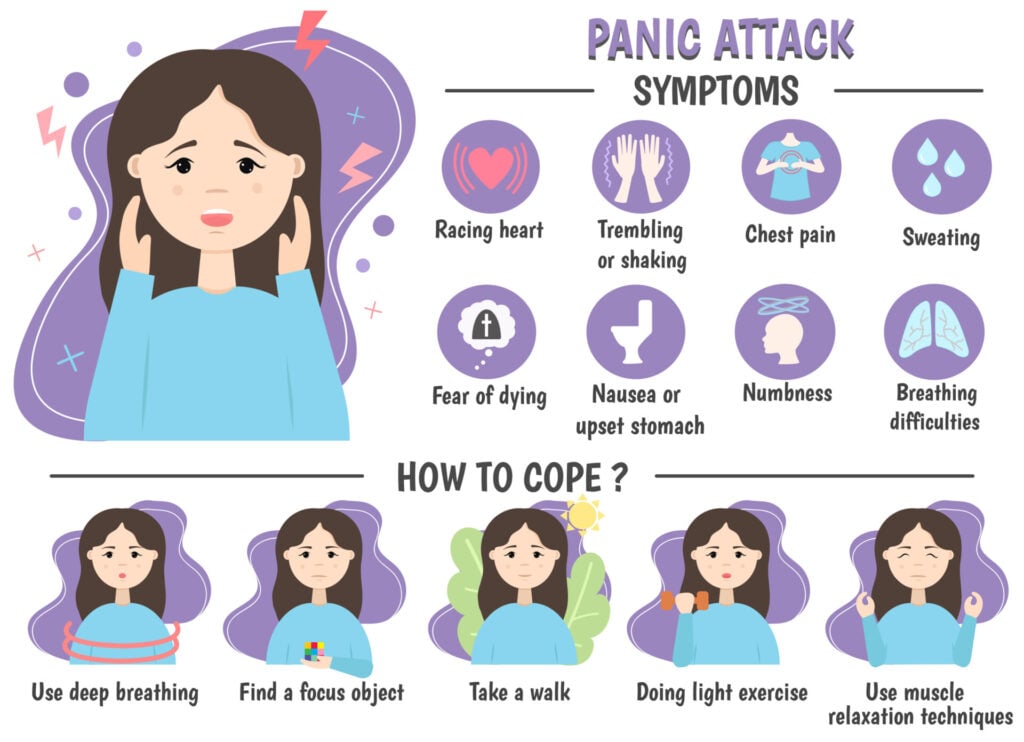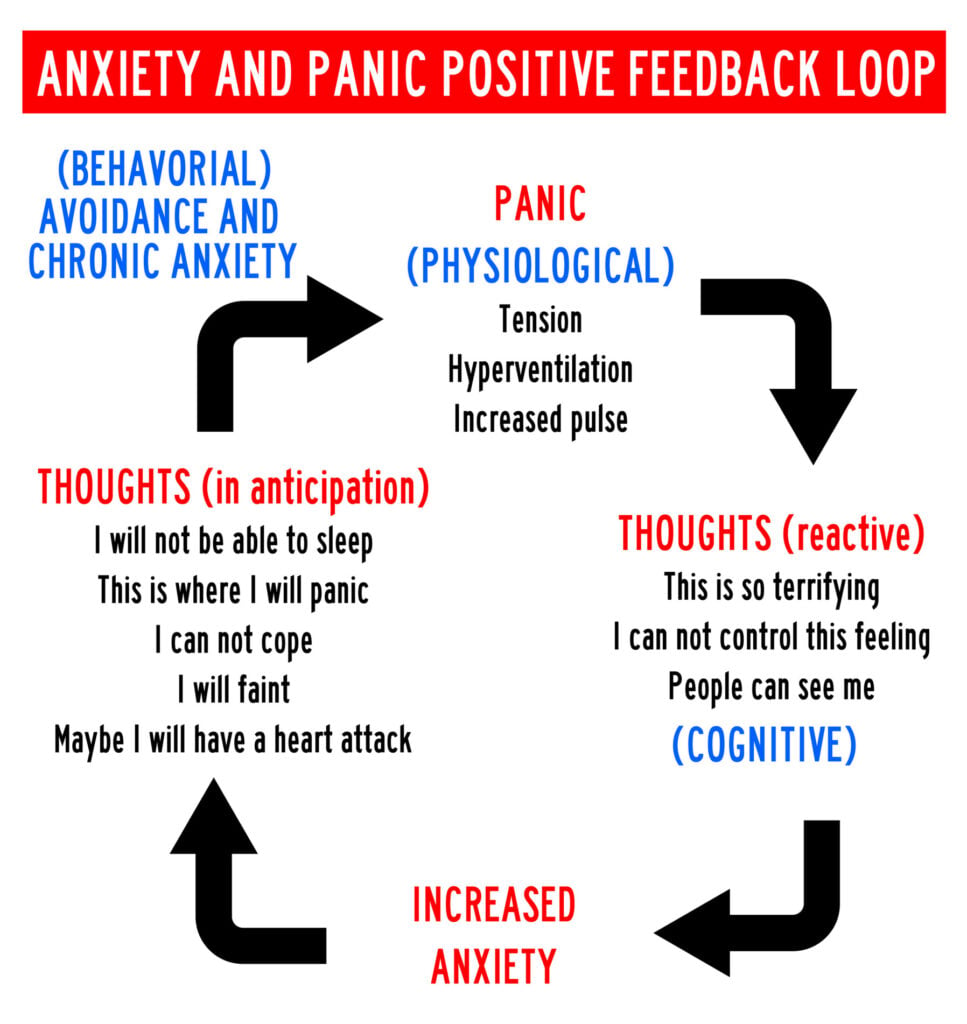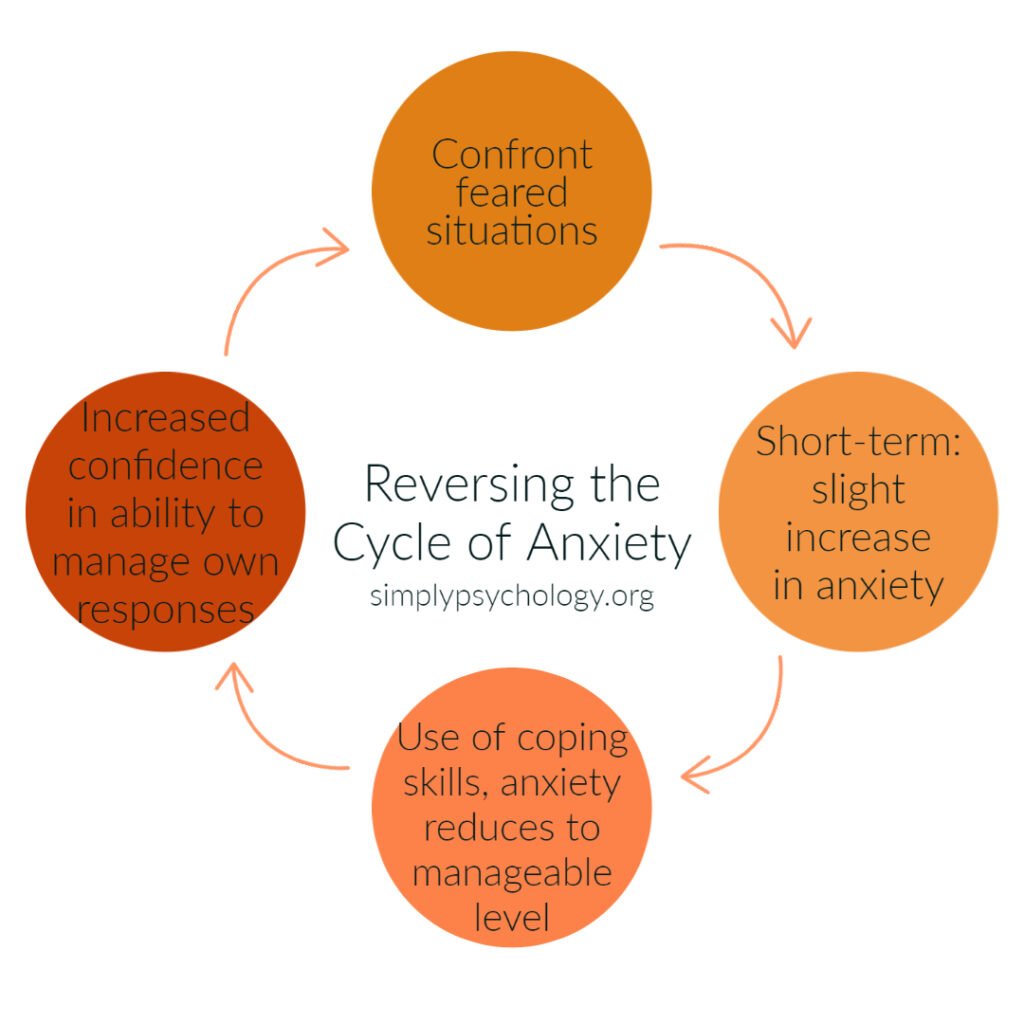On This Page:
A panic attack is a sudden episode of intense fear or anxiety that triggers severe physical reactions, such as a racing heart, sweating, trembling, shortness of breath, or a feeling of impending doom, even though there’s no real danger or apparent cause.
A panic attack can typically last between 5 to 20 minutes, reaching a peak of symptoms within 10 minutes. In extreme cases, the symptoms may last for more than one hour.
Since panic attacks cannot always be predicted, they can significantly affect everyday life.

Drowning in Sensations
Many people living with panic disorder describe feeling as though they are having a heart attack or on the verge of dying. The feeling may be so intense that they may seek emergency medical assistance, especially if they are unaware that they have panic disorder.
Tony’s account offers a vivid description of his experiences with panic attacks, beginning with an ominous feeling and a literal impairment of his vision.
He then feels a constriction in his chest, specifically around his heart, progressing to a point where he feels physically immobilized.
Tony shared, “It always starts with a sense of doom and literal clouded vision for me that’s followed by a compression in my chest and a pretty severe compression in my heart. And then I get to a point where I feel literally locked, like even if I wanted to move my arms or my legs or walk away from a situation, that I couldn’t.”
Symptoms such as difficulty breathing and intense fear of impending death, as described by Tony, are commonly reported in panic disorder.
The impending sense of doom is a common precursor to panic attacks, often signaling the start of the intense fear and anxiety that follows. The chest compression he describes is likely reflective of the physical sensations of intense fear and anxiety, such as heart palpitations or a feeling of choking.
His feeling of being locked or frozen is a testament to the disabling nature of panic attacks, affecting not only his emotional state but also his ability to respond physically.
This highlights the all-encompassing impact of panic attacks, touching on the emotional, physical, and cognitive aspects of an individual’s functioning.
Azita was 17 when she first experienced a panic attack. Her symptoms began with a struggle to breathe, followed by an overwhelming fear of fainting, illustrating how panic attacks can evoke an intense sense of dread and confusion.
Azita said, “At first, I struggled to breathe, and then I felt like I was going to faint on the floor, it was terrifying, and I was just panicking, and I just kept trying to hold on to my mum and like squeeze her. I didn’t understand what was going on or why I felt that way, so I was, I was confused as well. I thought I would die.”
This firsthand account of a panic attack reflects the scientific consensus of these episodes. They typically present with symptoms of severe physical discomfort, often mistaken for life-threatening conditions, leading to a cycle of fear and confusion.
In this case, the feeling of wanting to hold onto someone familiar, like her mother, can be seen as a natural response to seeking comfort and safety in an extremely distressing situation.
Panic attack hangover
A panic attack hangover refers to the lingering physical and emotional symptoms experienced after a panic attack. Even when the acute attack subsides, the body might feel exhausted, tense, or shaky from the intense adrenaline surge.
Some symptoms may fade within a few hours, while others can linger for a day or even several days.
Emotionally, individuals may feel drained, hypersensitive, or apprehensive about another potential attack.
This state of heightened awareness and physical discomfort can create a prolonged period of distress, making it feel like a “hangover” from the initial episode.
Lack of Control
Eva provides a poignant depiction of her experience with panic attacks. Her description sheds light on the lack of control and overwhelming sensations that characterize these distressing episodes, affecting her physical strength and ability to function.
Eva said, “It’s just kind of being overwhelmed with all these feelings that you can’t really control or like hide in a way, like it just all kind of floods out of you and makes you feel really weak. It just makes me feel really weak like I can’t, I feel like I can’t walk properly, like I just feel really like, not capable of doing things.”
Eva’s experience aligns with the typical presentation of panic attacks. Feeling overwhelmed by uncontrollable emotions is a common description among individuals experiencing panic attacks.
The physical weakness she mentions, such as her difficulty walking, may be due to the physical exhaustion and muscle tension that can follow the intense surge of adrenaline during an attack.
The perceived incapacity to perform regular tasks underscores the disabling nature of these episodes, affecting not just psychological but also physical functioning.
Tanya and Alexandra are among many individuals who use distraction as a coping mechanism during panic attacks. Distraction can serve as a protective factor, helping divert attention away from the overwhelming sensations and fears associated with the attacks.
For Tanya, the uncertainty of what may happen without this defense mechanism creates additional apprehension. It is apparent that the fear of the unknown amplifies her anxiety.
Tanya shared, “‘I don’t know what would happen if I didn’t distract myself . . . I don’t know what would be on the other side of that, what would happen, it’s not something I’m willing to take a risk to find out.”
Alexandra shares her attempts to manage her panic attacks using a breathing technique taught by a friend.
However, she finds that sometimes these techniques not only fail to alleviate her symptoms but may even intensify them, leading her to feel more distressed.
Alexandra said, “I’ve tried this breathing technique a friend taught me. Breathe in four breaths, hold for four, breathe out for six. Sometimes it will do absolutely nothing.
Sometimes it will just make it worse. The feelings I’m getting have just been intensified.
I’ve tried to calm it down thousands of times, but I just can’t get it to calm down. So, then it stresses me out even more, because I’ve just got to the point where I just let them just go.
At the moment I’m just trying, I just try and ignore them at the moment because I, I know I can’t do anything to calm down at this point, but I try sometimes, it just makes them worse… So realistically, I’ve just given up trying to calm them down.”
Alexandra’s account reveals the complexity of managing panic attacks. The breathing technique she mentions is a commonly suggested coping strategy, but as Alexandra’s experience suggests, it may not always be effective for everyone.
This inconsistency underscores the highly individual nature of panic disorder and the challenge of finding universally effective coping strategies. Her eventual resignation from her panic attacks demonstrates the immense frustration and helplessness people with panic disorder can feel.
While distraction can provide immediate relief, it may also prevent her from directly addressing and managing her fear, thereby perpetuating the cycle of anxiety.
It speaks to the importance of personalized therapeutic approaches to manage and mitigate the impacts of this debilitating condition.
Lilly describes a feeling of entrapment and breathlessness during her episodes. These feelings create a distressing environment that is difficult for her to escape from.
Lilly said, “I just felt like I was trapped. I was trapped, I couldn’t breathe. I don’t really know how to describe it but it’s, it’s not nice, because you feel like you can’t get out.”
Embracing a Lack of Control
Ben recognized that emotions and panic responses can be automatic, arising without conscious thought or intent. This idea aligns with the concept that we cannot always control what we feel, but we can control how we react to these feelings.
Ben shared, “Understanding that I’m not in control of my feelings I understand the time understanding that as long as I keep breathing as long as I relax myself I can use physical things and consciously change my physical position and mindset that I’m in consciously in control of to affect my unconscious mind which deals with my body processes.”
Panic attacks are time-limited, typically peaking within 10 minutes and then gradually subsiding. This realization can help reduce the fear associated with panic attacks.
Under the Social Spotlight
Azita’s testimony provides a glimpse into the internal conflict that people suffering from panic attacks often face.
On one hand, she experiences intense distress and the urge to express it openly; on the other, she’s aware of societal perceptions and potential judgment, leading her to try and mask her symptoms.
Azita said, “I’m trying, I’m trying to hide what’s going on, but I can’t, because in the moment you want to scream, you can’t breathe, you’re freaking out, but you also don’t want anyone to stare at you or to realize what’s going on, because obviously they won’t understand what’s going on.
That kind of makes it worse, because while you’re trying to manage a panic attack, you’re also trying to look like you’re not having one, because you don’t want people’s judgment and even afterwards, you’re embarrassed because everyone just saw you freak out.”
This quote embodies the scientific consensus that panic attacks often involve a complex interaction between the individual’s internal experience and their external environment.
The intense physical and emotional distress that Azita describes is a typical response during panic attacks, characterized by feelings of breathlessness and fear.
Simultaneously, her concern about external judgment and lack of understanding from others highlight the social anxiety that often co-occurs with panic disorder.
The added pressure to conceal her symptoms and appear ‘normal’ to avoid judgment could exacerbate the severity of the panic attack, demonstrating how the individual’s environment can affect their experience of the disorder.
Social worries can feed into the panic cycle, increasing symptoms and intensifying the unpleasantness of the overall experience, as worrying about the social implications intensifies everything and “makes it worse.”
Emma shares her experience of dealing with panic attacks in social settings. She underscores the distress she feels when her panic attack symptoms draw attention, which then inadvertently intensifies her symptoms.
Emma said, “It just brings attention to you, and you don’t want attention. I’m like kind of breathing quite heavily, that’s when other people start to notice, and then if someone um just looks at me, or asks if I’m ok, then it’ll get faster, cus I know that people are starting to realize, and then I’ll start getting a few more [symptoms].”
The dread of perceived social judgment or misunderstanding can indeed exacerbate the symptoms, underscoring the multifaceted nature of panic attacks, which involve not only physical sensations but also cognitive and social dynamics.
Vicious Circle of Anxiety
One of the worst reported feelings associated with panic attacks is the intense fear of experiencing another panic attack. Sometimes, even the fear of having another panic attack can trigger another for some people.
Olivia details how her worries snowball into an incessant cycle of fear and anxiety. This process, in turn, leads to further health concerns, including fears about potentially having a heart attack.
Olivia said, “I always catastrophize about it. I was worried that I’d feel nervous, then it kept on going round and round like a vicious kind of circle, and then I started to kind of get like, develop more worries for like my health, and like I was going to have a heart attack.”
Olivia’s experience mirrors the scientific understanding of the cycle of panic. The tendency to catastrophize, or imagine the worst possible outcome, often exacerbates the fear and anxiety associated with panic attacks.
The cyclical nature of these worries creates a feedback loop, where fear fuels more fear, contributing to the perpetuation of the disorder.
Her concern about having a heart attack is a common fear among people with panic disorder, reflecting the intense physical symptoms that often mimic those of serious heart conditions.
This highlights the significant impact that panic attacks can have on an individual’s mental and perceived physical health.

Unhelpful Helpers
Emma shares her frustrations when others attempt to help during her panic attacks. While the intentions are good, their advice often doesn’t help and sometimes increases her stress and discomfort.
Emma shared, “Sometimes people try and help, but it doesn’t help and then I get mad at them cus they’re telling me to do this thing, and I’m like, that doesn’t work, I’ve already tried.
I know they’re trying to help me, but it doesn’t help. They [school staff] were saying ‘breathe in now’ and then like if I didn’t then they kept telling me that I’m not listening to them.
It doesn’t help. They kept standing over me and stuff and like threatening to, they were like ‘if you don’t come now, we’ll do this’ and stuff and they kept asking me questions and I couldn’t respond, so they, they started calling me rude.”
Emma’s account highlights an important point in the understanding of panic disorder. The complexity of the disorder often means that well-intentioned advice may not necessarily be helpful or constructive and may even inadvertently exacerbate the person’s distress.
This underscores the importance of education and awareness about panic disorder, not just for those experiencing it but also those likely to be in supportive roles.
Understanding the right ways to help during a panic attack can make a significant difference in managing the condition.
Self-Help Resources


Key sources
American Psychiatric Association. Diagnostic and Statistical Manual of Mental Disorders. 5th edition. American Psychiatric Association; 2013.
Baker, H. J., Hollywood, A., & Waite, P. (2022). Adolescents’ lived experience of panic disorder: an interpretative phenomenological analysis. BMC psychology, 10(1), 143.
Hewitt, O. M., Tomlin, A., & Waite, P. (2021). The experience of panic attacks in adolescents: an interpretative phenomenological analysis study. Emotional and Behavioural Difficulties, 26(3), 240-253.
Lattari, E., Budde, H., Paes, F., Neto, G. A. M., Appolinario, J. C., Nardi, A. E., Murillo-Rodriguez, E. & Machado, S. (2018). Effects of aerobic exercise on anxiety symptoms and cortical activity in patients with panic disorder: a pilot study. Clinical practice and epidemiology in mental health: CP & EMH, 14, 11.
Locke, A. B., Kirst, N., & Shultz, C. G. (2015). Diagnosis and management of generalized anxiety disorder and panic disorder in adults. American family physician, 91(9), 617-624.
National Institutes of Mental Health. Panic disorder: When fear overwhelms.
Nathan, P., Correia, H., & Lim, L. (2004). Panic Stations! Coping with Panic Attacks. Perth: Centre for Clinical Interventions.

